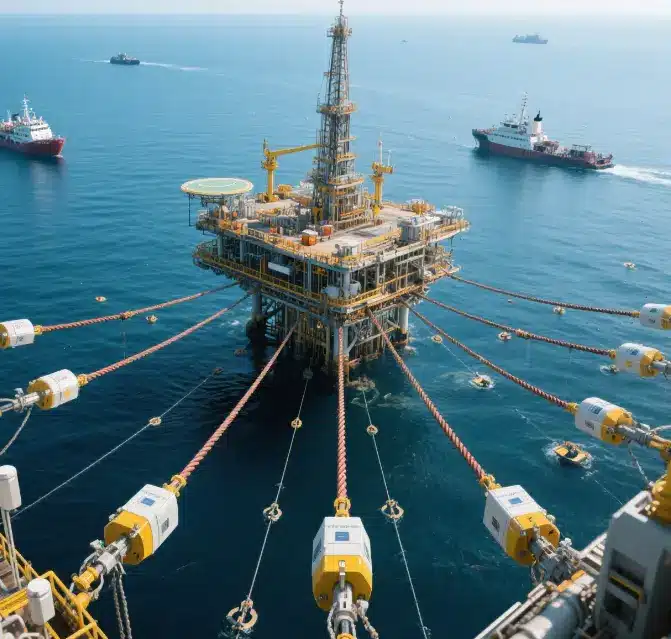
I. Hidden Threats of Mooring Operations
When ships dock at the wharf, mooring ropes are the key defense line against wind, waves and tides. However, cable tension control conceals risks:
- Tension beyond limitIt will instantly break the cable, and the rebound speed of the broken cable can exceed 60 meters per second, comparable to that of a cannonball.
- Insufficient tensionIt causes the vessel to drift, resulting in minor collisions with wharf facilities and severe impacts on adjacent vessels.
- Tides rise and fall, loading and unloading of goods, and sudden wind strikesFactors such as continuous changes in the force state make it difficult for manual inspections to respond in a timely manner.
Ii. Core Value of the System: Making invisible forces controllable
The mooring rope tension monitoring system is the "neural perception network" of the wharf, achieving three major breakthroughs:
- Real-time perceptionMonitor the force value of each cable in milliseconds with an accuracy of ±1%FS.
- Dynamic protectionAutomatically set the tension safety range based on the tonnage, load capacity and weather conditions of the vessel.
- Intelligent linkageWhen the limit is exceeded, an audible and visual alarm is triggered, and the winch is automatically controlled to tighten or release the cable.
- Global visibilityThe central control large screen centrally displays the mooring status of the entire vessel, making risks clear at a glance.
"Technical core"By integrating high-stability strain sensing, industrial Internet of Things communication, and adaptive control algorithms, a closed-loop protection system is constructed.
Iii. How does the System Build a Secure Closed Loop?
The first step: All-round perception
- Install explosion-proof tension sensors on mooring piles/cable guides to withstand salt spray corrosion.
- The laser displacement meter monitors the changes in the distance between the hull and the wharf in real time.
Step 2: High-speed data fusion
- Data is transmitted via dual-redundant industrial buses (CAN/ProfiBus).
- 5G wireless backup ensures that communication is not interrupted in extreme weather.
Step 3: Intelligent Decision-making Hub
- The core algorithm dynamically calculates the security threshold (such as the breaking strength from 30% to 80%).
- The predictive model, in combination with data from meteorological stations, predicts the trend of tension fluctuations.
Step 4: Proactive safety execution
- When a single rope is overloaded: Automatically release the cable or link the adjacent winch to share the load.
- When the ship drifts: Tighten the mooring line urgently and issue a three-level audible and visual alarm.
- Generate operation logs and synchronously push alarm information to the mobile phones of on-duty personnel.
Fourth, these scenarios urgently need system support
- Large container terminalThe mooring capacity of the 10,000-TEU class vessel exceeds 1,000 tons, and the system prevents quay crane collision accidents caused by broken cables.
- LNG receiving terminalIn a low-temperature environment of -162℃, the built-in temperature compensation algorithm ensures that the risk of cable embrittlement is controllable.
- A port with significant tidal rangeThe adaptive algorithm automatically adjusts the tension safety range in accordance with the changes in tide level.
- Automated terminalInteract with the AGV dispatching system to ensure mooring safety during unmanned operations.
V. Four Rigid Benefits of Deploying the System
- Upgrade of intrinsic safety
- Reduce the rate of cable breakage accidents by 92% and avoid the risk of rebound casualties.
- Eliminate the collision losses of tens of millions caused by ship drift.
- The operational efficiency has jumped
- The manual inspection time of 75% was reduced, and the continuity rate of wharf operations was improved.
- It can still be safely mowed in strong winds of force 8, extending the loading and unloading window period.
- The lifespan of the equipment has been doubled.
- Prevent plastic deformation caused by cable overload and extend the service life by three times.
- Reduce the frequent start and stop losses of the winch mechanism and save 40% in maintenance costs.
- Compliance and traceability guarantee
- Record tension data throughout the entire cycle to meet the requirements of the SOLAS convention and port state inspections.
- When an accident occurs, the complete data chain supports liability definition and insurance claims.
Vi. Key Points for Efficient Operation and Maintenance
- Precise installationThe sensor axis must coincide with the force direction of the cable to avoid lateral force interference.
- Intelligent calibration:
- The initial calibration adopts bidirectional tension and compression calibration (50kN/150kN reference points).
- Drift correction is carried out every quarter to ensure that the full-range error is ≤±1.5%.
- Predictive maintenance:
- Based on AI analysis of the tension fluctuation spectrum, cable fatigue is warned two weeks in advance.
- The cloud-based remote diagnosis of the system status has reduced the fault response time to one hour.
Vii. Technological Evolution: Evolving towards Intelligent Twins
- Full-scene 3D mappingReal-time display of the cable force heat map in the digital twin platform;
- Upgrade of autonomous decision-makingDeep reinforcement learning algorithms autonomously optimize tension control strategies;
- Wind-solar coupling early warningAccess meteorological radar data and pre-adjust the protection level one hour in advance.
- Blockchain evidence storageEncrypt and store operation records to build an unalterable security audit chain.
Conclusion: Reconstructing the underlying logic of port security
The mooring rope tension monitoring system is transforming the safety paradigm of ports
From passively bearing risks to real-time predictive intervention;
From relying on human experience to data-driven decision-making.
It makes the "breathing pulse" of each mooring rope clearly visible, building an intelligent defense line at critical moments.
This is not only a technological upgrade, but also the ultimate protection of life and property.
